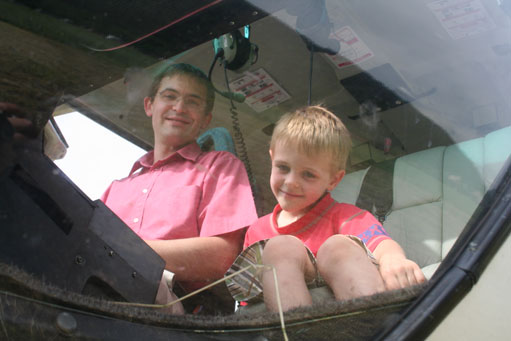Marc Dobson
22 July 2008 | By

Marc Dobson plays something of a lynchpin role at ATLAS; he’s one of those utterly essential people whose true value you only discover when things are going wrong and all Hell is breaking loose.
Together with his colleague Gokhan Unel, Marc is responsible for the system administration of ATLAS. Between them, they look after a team of six or seven people, taking care of issues ranging from networking and registration tasks, to the maintenance of the web servers at Point 1, to installing the machines in the control room. “We make sure we have mirror copies of everything IT has,” he says, “so that if we’re ever cut off, we can continue running on our own.”
Not only that, Marc’s team is also responsible for installing all the Linux machines in Point 1 – from the front-end boards which receive data directly from the detector, to the file server computers that are used to boot these devices by loading the operating system over the network and running from memory.
Also under Marc’s watchful eye are the “computing farms” – racks of computers at Point 1 that support the software-based Level 2 and Level 3 trigger systems, which will select the collision events which look interesting enough to retain and study. By this summer, the farms will consist of around 950 processors, but the final configuration will include over 2,500 individual nodes.
The variety of the demands on Marc’s time, along with their highly specialised nature, mean he has carved out rather a niche role for himself at ATLAS. “We’re both trigger data acquisition people originally,” he says of himself and Gokhan, who are often mistakenly described as IT people working for ATLAS. “We have a good knowledge of how T/DAQ works, and how the detector works as well, which allows us to understand the needs of the users when they want specific tasks to be done or specific configurations for their machines.”
Speaking of people having niche roles, this is one of the main benefits of working somewhere like ATLAS, according to Marc: “You can get expertise on just about any problem that you have here, just by picking up the phone and ringing someone. It really opens up your horizons in terms of what can be done at CERN and how you can do it,” he explains, “which is very important to me.”
He also cites the freedom for development, and for putting forward new ideas, afforded to ATLAS contributors as another big hit with him: “It’s a fairly unique environment in that respect,” he says, enthusing about the fact that, “there’s always the possibility to say, ‘Ah! I’ll give you a hand with that!’ and see something new, do something different, and learn more about how the experiment works.”
For someone so spiritually at home in the working environment here, it is perhaps surprising that Marc hadn’t even heard of CERN until he began his PhD. In fact, that he did a PhD in particle physics at all was something of a happy accident. Towards the end of his undergraduate degree in applied physics and electronics at Royal Holloway, University of London, his supervisor asked him if he had considered doing a higher degree. “I was thinking of going and working,” Marc remembers, “but he told me I should think about it, so I thought ‘well, ok, let’s give it a go then.’”
Once he settled on particle physics, he soon heard of CERN, of course, but coming here for the first time was again an opportunity rather than a dream. “I ended up doing my thesis on ATLAS,” he says, “and had the chance to come here for six months.” This proved to be a turning point. He was bitten by the CERN bug, and has been here ever since, first on a two-year fellowship, working on T/DAQ; then in the same area, with the University of Copenhagen. Six months on, he had secured a CERN staff position, working on data acquisition software and testing for over five years. “After that, it was a natural progression that I went into the group looking at the computing needs which we had for ATLAS,” he reasons, “and I gradually went into leading the team which was putting it in place.”
As well as fitting easily into life at CERN, he and his wife found Geneva an easy place to settle down. “I immediately enjoyed it,” remembers Marc, who grew up in Morocco, France and Tunisia, where his father was a pastor. “It’s not a big place, you don’t get lost, and there isn’t concrete everywhere – it’s a very pleasant place to live. And of course the area is magnificent – the mountains, the lake… even the coast isn’t that far away.”
And he should know; Marc has many a time had the privilege of seeing all this beautiful scenery from the air, after learning to fly ultralites six years ago. “My goal was always to own such an aircraft myself,” he says. “I actually bought one which needs repairing, but haven’t managed to do that over the last four years.” Instead, his free time has been dominated by building a house for his family – he has a son and daughter aged seven and four respectively – and working on the inside of it. “You could say that my major work outside CERN these days is handyman,” he laughs.
Which brings us full circle, back to the benefits of working within a talented, multidisciplinary community: “I wasn’t much of a handy person when I started, but I had colleagues who were. I learnt a lot from them. We often had coffee together, talking about a problem and finding a solution together. It applies to work, but also to life outside,” he smiles. “There’s always someone around who has a solution to your problem."



